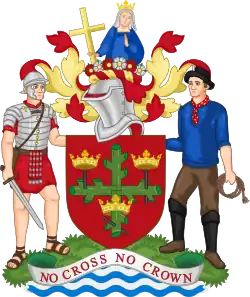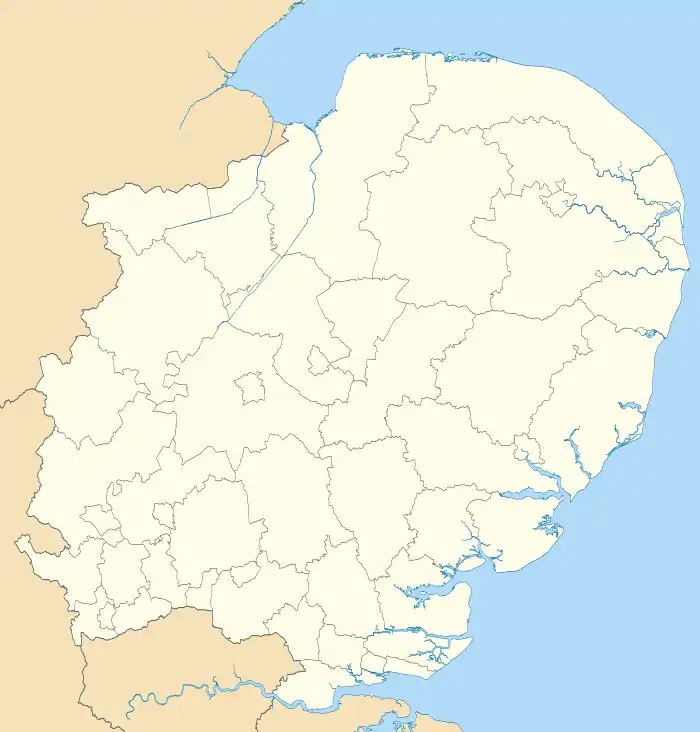City of Colchester | |
|---|---|
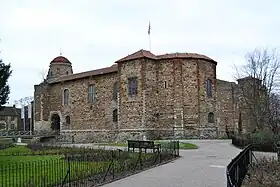 Colchester Castle in Colchester, the administrative centre and largest settlement | |
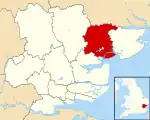 Colchester shown within Essex | |
| Sovereign state | United Kingdom |
| Constituent country | England |
| Region | East of England |
| Non-metropolitan county | Essex |
| Status | Non-metropolitan district, City, |
| Admin HQ | Colchester |
| Incorporated | 1 April 1974 |
| Government | |
| • Type | Non-metropolitan district council |
| • Body | Colchester City Council |
| • Leadership | (Liberal Democrat (council NOC)) |
| • MPs | Bernard Jenkin Priti Patel Will Quince |
| Area | |
| • Total | 128.64 sq mi (333.18 km2) |
| • Rank | 115th (of 296) |
| Population (2021) | |
| • Total | 192,424 |
| • Rank | 102nd (of 296) |
| • Density | 1,500/sq mi (580/km2) |
| • Ethnicity | 87% White 5.1% Asian 3.5% Black 2.9% Mixed 1.5% Other |
| Time zone | UTC0 (GMT) |
| • Summer (DST) | UTC+1 (BST) |
| ONS code | 22UG (ONS) E07000071 (GSS) |
| OS grid reference | TL997254 |
The City of Colchester is a local government district with city status in Essex, England, named after its main settlement, Colchester. The district also includes the towns of West Mersea and Wivenhoe and the surrounding rural areas stretching from Dedham Vale on the Suffolk border in the north to Mersea Island in the Colne Estuary in the south.
The neighbouring districts are Maldon, Braintree, Babergh, and Tendring.
History
Colchester stands on the site of Camulodunum, which had been an important stronghold of the Trinovantes and Catuvellauni tribes in the Iron Age prior to the Roman conquest of Britain in 43 AD. The Romans subsequently developed Camulodunum into the first capital of their province of Britannia. They later moved their capital to Londinium (London). Following the end of Roman rule in Britain in the early 5th century, the area was settled by Anglo-Saxons, and the town on the site of Camulodunum became known as Colchester.[1]
Colchester was an ancient borough with urban forms of local government from Saxon times. Burgesses were already established by the time of the Domesday survey of 1086. The earliest known borough charter dates from 1189, but that charter appears to confirm pre-existing borough rights rather than being the foundation of a new borough.[2] The borough was reformed in 1836 to become a municipal borough.[3]
The current district was formed on 1 April 1974, under the Local Government Act 1972, covering four former districts which were abolished at the same time:[4]
- Colchester Municipal Borough
- Lexden and Winstree Rural District
- West Mersea Urban District
- Wivenhoe Urban District
The new district was named Colchester after its largest settlement.[5] The new district was awarded borough status from its creation, allowing the chair of the council to take the title of mayor, continuing Colchester's series of mayors.[6]
As part of the Platinum Jubilee of Elizabeth II celebrations in 2022, the borough of Colchester was granted city status, confirmed by Letters Patent dated 5 September 2022, allowing the council to change its name to "Colchester City Council".[7]
Governance
Colchester City Council | |
|---|---|
 | |
| Type | |
| Type | |
| Leadership | |
Pamela Donelly since 1 April 2022[8] | |
| Structure | |
| Seats | 51 |
Political groups |
Other parties (35)
|
| Elections | |
Last election | 4 May 2023 |
Next election | 2024 |
| Meeting place | |
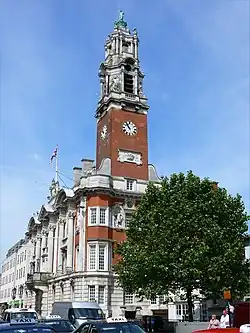 | |
| Town Hall, High Street, Colchester, CO1 1PJ | |
| Website | |
| www | |
Colchester City Council provides district-level services. County-level services are provided by Essex County Council. Parts of the district are also covered by civil parishes, which form a third tier of local government.[9]
Political control
The council has been under no overall control since 2008. Since the 2023 election it has been controlled by a Liberal Democrat minority administration.[10]
The first election to the borough council following the reforms of the Local Government Act 1972 was held in 1973, initially operating as a shadow authority alongside the outgoing authorities until the new arrangements came into effect on 1 April 1974. Political control of the council since 1974 has been as follows:[11][12][13]
| Party in control | Years | |
|---|---|---|
| No overall control | 1974–1976 | |
| Conservative | 1976–1986 | |
| No overall control | 1986–1994 | |
| Liberal Democrats | 1994–1998 | |
| No overall control | 1998–2007 | |
| Conservative | 2007–2008 | |
| No overall control | 2008–present | |
Leadership
The role of mayor is largely ceremonial in Colchester. Political leadership is instead provided by the leader of the council. The leaders since 2000 have been:[14]
| Councillor | Party | From | To | |
|---|---|---|---|---|
| Bill Frame | Liberal Democrats | 2000 | 2002 | |
| Colin Sykes | Liberal Democrats | 2002 | 2004 | |
| John Jowers | Conservative | 2004 | 2006 | |
| Robert Davidson | Conservative | 2006 | 2008 | |
| Anne Turrell | Liberal Democrats | 2008 | 16 Jun 2014 | |
| Martin Hunt | Liberal Democrats | 16 Jun 2014 | 10 May 2015 | |
| Paul Smith | Liberal Democrats | 27 May 2015 | 6 May 2018 | |
| Mark Cory | Liberal Democrats | 23 May 2018 | 26 May 2021 | |
| Paul Dundas | Conservative | 26 May 2021 | 8 May 2022 | |
| David King | Liberal Democrats | 22 May 2022 | ||
Composition
Following the 2023 Highwoods by-election, the composition of the council was:
| Party | Councillors | |
|---|---|---|
| Conservative | 19 | |
| Liberal Democrats | 16 | |
| Labour | 15 | |
| Green | 2 | |
| Total | 51 | |
The next election is due in 2024.
Premises
The council is based at Colchester Town Hall on the High Street. The current building was completed in 1902 on a site which had been occupied by Colchester's main civic buildings since 1277.[15]
Elections
Since the last boundary changes in 2016 the council has comprised 51 councillors representing 17 wards, with each ward electing three councillors. Elections are held three years out of every four, choosing one councillor for each ward at a time to serve a four year term. In the fourth year of the cycle when there are no elections to the city council, elections for Essex County Council are held instead.[16]
Demography


According to the Office for National Statistics as of 2008, Colchester had a population of approximately 181,000.[17] Average life expectancy was 78.7 for males. and 83.3 for females.[18]
Based on ethnic groups, predominantly of 92% of the population is White (87.5% British, 0.7% Irish and 3.8% Other White), Asians were the second largest making up 3.6% (0.8% Indian, 0.2% Pakistani, 0.2% Bangladeshi and 1% Chinese, other 1.4%), Black people constituted 1.4% (0.3% Caribbean, 1% African, 0.1% other), those of mixed race made up 1.8%, 0.6% were Arab and there were 0.4% from other ethnic groups.[19]
In the 2011 census, 57.7% identified themselves as Christian, while 31.4% had no affiliation to a religion. Of other religions, 1.6% identified as Muslim, 0.7% Hindu, 0.6% Buddhist, 0.2% Jewish, 0.1% Sikh, 0.5% others, and 7.3% did not answer.[20] There are more than 100 churches located in Colchester: other religious places of worship include the Colchester Islamic Cultural Association and the Jewish Community Synagogue.
Parishes
There are 35 civil parishes in the district. The former Colchester Municipal Borough is an unparished area (subject to some adjustments since 1974 to that area's boundaries with neighbouring parishes).[21] The parish councils of Wivenhoe and West Mersea take the style "town council". Some of the smaller parishes are grouped together to share a parish council: Abberton and Langenhoe Parish Council covers those two parishes, and the Winstred Hundred Parish Council covers the four parishes of Great and Little Wigborough, Peldon, Salcott, and Virley. The two parishes of Layer Breton and Layer Marney have parish meetings rather than parish councils due to their small populations.[22]
- Abberton
- Aldham
- Birch
- Boxted
- Chappel
- Copford
- Dedham
- East Donyland
- East Mersea
- Eight Ash Green
- Fingringhoe
- Fordham
- Great and Little Wigborough
- Great Horkesley
- Great Tey
- Langenhoe
- Langham
- Layer Breton
- Layer de la Haye
- Layer Marney
- Little Horkesley
- Marks Tey
- Messing-cum-Inworth
- Mount Bures
- Myland
- Peldon
- Salcott
- Stanway
- Tiptree
- Virley
- Wakes Colne
- West Bergholt
- West Mersea (town)
- Wivenhoe (town)
- Wormingford
References
- ↑ Cooper, Janet; Elrington, C. R., eds. (1994). "Late Iron-Age and Roman Colchester". A History of the County of Essex: Volume 9, the Borough of Colchester. London: Victoria County History. pp. 2–18. Retrieved 4 June 2023.
- ↑ Cooper, Janet; Elrington, C. R., eds. (1994). "Medieval Colchester: Borough government". A History of the County of Essex: Volume 9, the Borough of Colchester. London: Victoria County History. pp. 48–57. Retrieved 4 June 2023.
- ↑ "Colchester Municipal Borough". A Vision of Britain through Time. GB Historical GIS / University of Portsmouth. Retrieved 4 June 2023.
- ↑ "The English Non-metropolitan Districts (Definition) Order 1972", legislation.gov.uk, The National Archives, SI 1972/2039, retrieved 31 May 2023
- ↑ "The English Non-metropolitan Districts (Names) Order 1973", legislation.gov.uk, The National Archives, SI 1973/551, retrieved 31 May 2023
- ↑ "District Councils and Boroughs". Parliamentary Debates (Hansard). 28 March 1974. Retrieved 16 January 2012.
- ↑ "Crown Office - The Gazette". 29 September 2022.
The Late QUEEN was pleased by Letters Patent under the Great Seal of the Realm dated 5 September 2022 to ordain that the Borough of Colchester shall have the status of a City.
- ↑ "Colchester Borough Council appoints new Chief Executive". BBC News. 21 December 2021. Retrieved 4 June 2023.
- ↑ "Local Government Act 1972", legislation.gov.uk, The National Archives, 1972 c. 70, retrieved 31 May 2023
- ↑ Dedman, Simon (24 May 2023). "Colchester: Power-sharing ends between Labour and Lib Dems". BBC News. Retrieved 4 June 2023.
- ↑ "Compositions calculator". The Elections Centre. 4 March 2016. Retrieved 1 June 2023.
- ↑ "Colchester". BBC News Online. 19 April 2008. Retrieved 2010-03-17.
- ↑ Wilkin, Chris (11 July 2007). "Colchester: Lib Dems furious at pair's defection to the Tories". Daily Gazette. Retrieved 30 May 2014.
- ↑ "Council minutes". Colchester Borough Council. Retrieved 10 June 2022.
- ↑ Baggs, A. P.; Board, Beryl; Crummy, Philip; Dove, Claude; Durgan, Shirley; Goose, N. R.; Pugh, R. B.; Studd, Pamela; Thornton, C. C. (1994). "'Municipal buildings', in A History of the County of Essex: Volume 9, the Borough of Colchester, ed. Janet Cooper and C R Elrington". London: British History Online. pp. 274–277. Retrieved 11 November 2020.
- ↑ "The Colchester (Electoral Changes) Order 2015", legislation.gov.uk, The National Archives, SI 2015/1859, retrieved 4 June 2023
- ↑ Colchester Resident Population ONS. Retrieved on 2010-03-07.
- ↑ Colchester Life Expectancy ONS. Retrieved on 2010-03-07.
- ↑ "Neighbourhood Statistics". Office for National Statistics (ONS). Retrieved 2012-12-22.
- ↑ "2011 Census: Religion, local authorities in England and Wales". Office for National Statistics (ONS). Retrieved 2012-12-22.
- ↑ "Election Maps". Ordnance Survey. Retrieved 5 June 2023.
- ↑ "Parish and Town Councils". Colchester City Council. Retrieved 5 June 2023.
